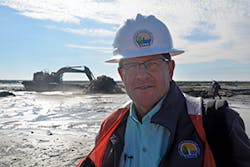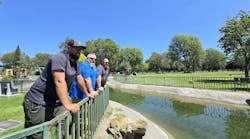Louisiana’s land loss crisis has claimed nearly 1,900 square miles since the 1930s. Without action, the state is poised to lose another 1,750 square miles. Increased flood risk creates potentially catastrophic conditions for southern Louisiana’s waterways, natural resources, wetlands, and culture. As a coastal restoration project manager for the Louisiana Coastal Protection and Restoration Authority (CPRA), Kenneth Bahlinger is on the front lines of an effort to mitigate the impending crisis. Throughout his personal and professional life, Bahlinger has developed a great respect for water.
“Water is what built our coast,” says Bahlinger of Louisiana’s coastline. “The Mississippi River brought the sediments and for thousands of years built our coastline. At the same time, the Gulf of Mexico brings storm surges not just from hurricanes but even from winter storms.”
Saving the barrier islands, marshes, and swamps helps reduce incoming storm surge and flooding impacts. CPRA estimates that without action, damage from flooding will increase from an average of $2.4 billion to $23.4 billion annually. CPRA is tasked with developing, implementing, and enforcing a comprehensive coastal protection and restoration master plan. Formed after Hurricane Katrina, CPRA combined the state’s Department of Natural Resources coastal restoration work and the Department of Transportation and Development’s protective efforts into one agency to strengthen their respective missions. CPRA also works with federal, state, and local political subdivisions, such as levee districts. One of the group’s biggest projects is the Bayou Dupont Marsh and Ridge Creation restoration project, which involves creating and nourishing approximately 300 acres of marsh through pipeline sediment delivery from the Mississippi River and creating a ridge along a portion of Bayou Dupont’s southwestern shoreline to help redefine the limits of Bayou Dupont and reestablish the natural bank. Water—be it overwash or current—can impact the projects as well as the soft organic soil conditions.
“Add to that sea level rise and it becomes a challenge in building these projects,” says Bahlinger. “We look at sustainability projects as 20- to 50-year projects.” Bahlinger knows his organization’s work is without end because of both human and natural impacts. “The system we’re constructing is a living system,” he says. “We’ve got to sustain it with continued projects. We keep trying to get sediments, take them out, and get further to the basin of need. It’s not something you build and walk away from it and say you’re done.”
What Led Him to This Line of Work
Bahlinger graduated from Louisiana State University in 1984 with a bachelor’s degree in landscape architecture. He worked at local design-build firms for about five years until 1991, when he took a job as a licensed landscape architect with Louisiana’s Department of Natural Resources’ coastal restoration program. He did vegetative planting and participated in the Christmas tree program, which uses recycled Christmas trees to create a “fence” to protect coastal marshes from erosion. In 2006, he began project management for large-scale ecosystem coastal restoration projects.
What He Does Day to Day
“As a project manager, I’ve got different people on the team—the engineers, the land rights person, and other agencies,” points out Bahlinger. “It’s a matter of communicating with people almost on a daily basis through e-mails and phone calls to make sure the work is getting done and staying on schedule. The work I’m doing is planned weeks ahead of time. I make sure that we can anticipate what’s going on so we can resolve any issues and the projects can run as smoothly as possible.”
What He Likes Best About His Work
“I like the people I work with,” says Bahlinger. “Some of what we’re doing has never been done before. We have these ideas of how we’re going to move sediment 22 miles on a pipeline and use four booster pumps and actually see it happen. Seeing the fruit of our efforts pays off.”
His Biggest Challenge
As his organization tackles projects that are increasingly larger in scope, Bahlinger’s challenge is to see its dreams come to fruition. “It’s really fun what we’re doing,” he says. “We’re setting a precedent for others that have these types of issues. We learn to deal with things that have never been encountered before.”


